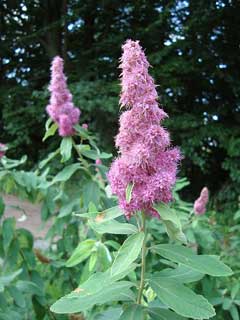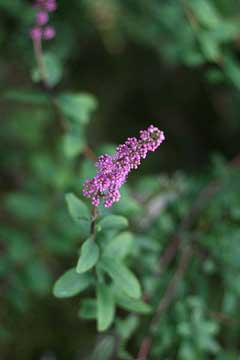 |
|
http://commons.wikimedia.org/wiki/User:Epibase |
 |
| http://commons.wikimedia.org/wiki/User:Epibase |
Translate this page:
Summary
Physical Characteristics

 Spiraea douglasii is a deciduous Shrub growing to 2.5 m (8ft 2in).
Spiraea douglasii is a deciduous Shrub growing to 2.5 m (8ft 2in).
See above for USDA hardiness. It is hardy to UK zone 5. It is in flower from June to September. The species is hermaphrodite (has both male and female organs) and is pollinated by Insects.
Suitable for: light (sandy), medium (loamy) and heavy (clay) soils. Suitable pH: mildly acid, neutral and basic (mildly alkaline) soils. It can grow in semi-shade (light woodland) or no shade. It prefers moist soil.
UK Hardiness Map
US Hardiness Map
Synonyms
S. menziesii.
Plant Habitats
Woodland Garden Sunny Edge; Dappled Shade; Shady Edge;
Edible Uses
References More on Edible Uses
Medicinal Uses
Plants For A Future can not take any responsibility for any adverse effects from the use of plants. Always seek advice from a professional before using a plant medicinally.
An infusion of the seeds has been used in the treatment of diarrhoea[257].
References More on Medicinal Uses
The Bookshop: Edible Plant Books
Our Latest books on Perennial Plants For Food Forests and Permaculture Gardens in paperback or digital formats.

Edible Tropical Plants
Food Forest Plants for Hotter Conditions: 250+ Plants For Tropical Food Forests & Permaculture Gardens.
More

Edible Temperate Plants
Plants for Your Food Forest: 500 Plants for Temperate Food Forests & Permaculture Gardens.
More

More Books
PFAF have eight books available in paperback and digital formats. Browse the shop for more information.
Shop Now
Other Uses
The branches have been used to make brooms[257].
Special Uses
References More on Other Uses
Cultivation details
Tolerates most soils[200], but prefers a good loamy soil, abundant moisture and full sunlight[11, 200]. Prefers a moist lime-free soil[182], plants quickly become chlorotic on chalk soils[200]. A very cold hardy plant, tolerating temperatures down to about -25°c[200]. Hybridizes freely with other members of this genus[11]. A rampant suckering shrub, it quickly produces dense thickets and can be used for large-scale naturalistic plantings[200]. It is apt to get thin and poor unless divided up fairly regularly and replanted in fairly good soil[1].
References Carbon Farming Information and Carbon Sequestration Information
Temperature Converter
Type a value in the Celsius field to convert the value to Fahrenheit:
Fahrenheit:
The PFAF Bookshop
Plants For A Future have a number of books available in paperback and digital form. Book titles include Edible Plants, Edible Perennials, Edible Trees,Edible Shrubs, Woodland Gardening, and Temperate Food Forest Plants. Our new book is Food Forest Plants For Hotter Conditions (Tropical and Sub-Tropical).
Shop Now
Plant Propagation
Seed - we have no information for this species but suggest sowing the seed as soon as it is ripe in a cold frame if possible. It is likely to require stratification before it germinates, so stored seed should be sown in a cold frame as early in the year as you receive it. Prick out the seedlings into individual pots when they are large enough to handle, and grow them on in a cold frame for their first winter. Plant them out in late spring or early summer of the following year. Cuttings of half-ripe wood, July/August in a light sandy soil a frame. Cuttings of mature wood of the current seasons growth, 15cm long, October/November in an outdoor frame[200]. Another report says that September is a good time to do this[11]. Division of suckers in early spring[200]. They can be planted out straight into their permanent positions.
Other Names
If available other names are mentioned here
Native Range
NORTHERN AMERICA: Canada (British Columbia), United States (Alaska (southeast), Idaho (north & central), Oregon, Washington, California (north))
Weed Potential
Right plant wrong place. We are currently updating this section.
Please note that a plant may be invasive in one area but may not in your area so it's worth checking.
Conservation Status
IUCN Red List of Threatened Plants Status :

Growth: S = slow M = medium F = fast. Soil: L = light (sandy) M = medium H = heavy (clay). pH: A = acid N = neutral B = basic (alkaline). Shade: F = full shade S = semi-shade N = no shade. Moisture: D = dry M = Moist We = wet Wa = water.
Now available:
Food Forest Plants for Mediterranean Conditions
350+ Perennial Plants For Mediterranean and Drier Food Forests and Permaculture Gardens.
[Paperback and eBook]
This is the third in Plants For A Future's series of plant guides for food forests tailored to
specific climate zones. Following volumes on temperate and tropical ecosystems, this book focuses
on species suited to Mediterranean conditions—regions with hot, dry summers and cool, wet winters,
often facing the added challenge of climate change.
Read More
Expert comment
Author
Hook.
Botanical References
17200
Links / References
For a list of references used on this page please go here
Readers comment